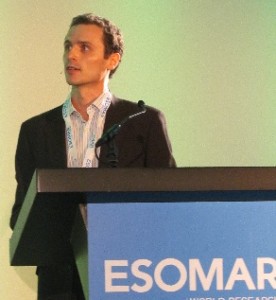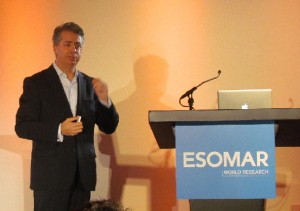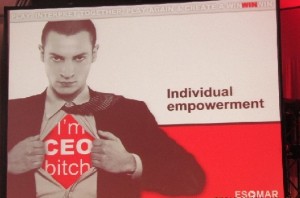WELCOME TO MIAMI – BIENVENIDO A MIAMI!
Defying the laws of nature – the ESOMAR 3D Digital Dimensions event in Miami opened to blue and sunny skies despite predictions of blustery tropical storms. With almost 200 delegates from over 30 countries, the conference is set to explore the evolving trends and impact of research in the online, mobile and social media space. Topics are ranging from why women rule the web to Gamification (yes, people this topic is here to stay for a while) to mobiles, mobiles and more mobiles and of course privacy and the social media space (an ESOMAR favourite).
So what will you see in this blog? Some reviews of the presentations, some video chats with speakers and delegates and, well, a general sneak peek into what some of the industry’s best are saying is up next for research and beyond.
Before the conference, ESOMAR Director General, Finn Raben, sat with the Chair of the ESOMAR Professional Standards Committee (PSC) to discuss some key issues on what the PSC sees as challenges for our future and how researchers, particularly young ones, can continue to work in a way that upholds the standards and integrity of our industry.
DAY 1 – ESOMAR 3D Digitial Dimensions Morning Sessions
The conference opened with a warm and informative speech from Mike Cooke, Vice President of the ESOMAR Council, who led the delegates through a brief introduction to the programme, some of ESOMAR’s key intiatives and some interesting highlights on Miami. Did you know that Miami is the cleanest and the richest city in the United States and is the only city conceived, financed and built by a woman – Julia Tuttle. As Mike noted, this is the perfect cosmopolitan environment for this event and full of historical and modern innovation and innovators.
Reg Baker – then gave a great overview of the history of this event from panels to online to the new 3 dimensions (online, social media and mobile) and intrdoduced the delegates to the programme content and how we are now knee deep in the co-creation of MR for the rest of the industry. He then introduced Phillip Sheldrake, keynote and founder of Meanwhile in the UK and Author of “The Business of Influence: Reframing Marketing and PR for the Digital Age”.
Phillip Sheldrake – Opening Keynote
“The business of influence is broken”. With those words, Sheldrake made us take pause. What impact do we have oncommunication? There is influence in everything and that must be remembered from all levels of our business from the mail room to the boardroom i.e.. no influence – then no communication effectiveness. We should be focus on changing hearts and minds and then we will influence and make a difference. Remember – we are more influenced by the 150 people nearest to us than the other 6 or so billion combined.
oncommunication? There is influence in everything and that must be remembered from all levels of our business from the mail room to the boardroom i.e.. no influence – then no communication effectiveness. We should be focus on changing hearts and minds and then we will influence and make a difference. Remember – we are more influenced by the 150 people nearest to us than the other 6 or so billion combined.
The areas that have affected us most:
- Rise in Social Media – no organisation is an island and everything we do occurs in the dynamic of a changing world. Treat all stakeholders with respect and cultivate sensitivity so you can sharpen your performance and be better than your competitors. Your brand value should be consistent, but not necessarily your brand. Times are a changing.
- Rise of info tech explosion – Think of that device in your pocket, what you had in 1995 or 2001. Not comparable is it? And this will only continue into the future. Remember this is the largest distributed sensory network in the world, so think of what can be achieved. As of this week we have 7 billion people on this planet – the things on the internet will far outnumber the people and this will change us as a society forever.
- Way we design, contemplate, communicate and execute strategy – We need to be introspective on how what we do affects all those external to our organisation. Socialising the enterprise demands more than just procuring some social tools. It demands a CEO-led organisational redesign and demands a new and simple model. How are we influencing our stakeholders properly and how are they influencing each other with regards to our organisation and brand? How can we be systematically ensuring that they are influencing us? The future of market research – focus on the market and not as much on the research!
The Future Foundation
Following keynote, Phillip Sheldrake, Dominic Harrison of The Future Foundation, gave the delgates a look at some never before seen research findings announced exclusively at this 3D event. 
Dominic explained how using their proprietary global research programme, nVision Global, (online quant survey, qual including focus groups, use of trend spotters and other sources covering 22 key consumer markets), the Future Foundation got to the heart of the global consumer’s relationship with the digital world in the years ahead.
A few key themes to takeaway:
Digitally Enhanced Downtime – now that consumers are better digitally equipped – they use their down time more constructively continuing to add value to their lives in one form or another. Mobile devices and mobile internet are only supporting this trend further. The Future Foundation has coined the term Smart Boredom to explain this rising phenomenon and that description is pretty spot on and represents a wider evolution in consumer attitudes – i.e. people want to enrich their spare time “with smart and self-improving activity [and this] will become a key characteristic of [their] mindset.”
Digital Etiquette and a Future of Identity Management – Focused on maturing relationships in the digital media space. People will start looking more at the benefits of digital footprint management…i.e. what are the perils of social broadcasting. In the UK 4 in 10 people between the ages of 16-24 have admitted they posted things in social networks they now wish they hadn’t. The use of restrictions on who can see what on a profile has grown across the globe. Important to note however, is that this digital management does not equal digital disengagement.
The Integration of the Play Ethic – 55% of GB smartphone owners using game apps at least once a month…Social gaming is a vast trend – in China 78% of social networkers have played a game within a social networking site. This area will continue to grow.
The Emergence of the Quantified Self – “Everyday the average person produces 6 newspapers worth of info compared to just two and a half in 1986.” With the use of apps this has had a tremendous impact in the fitness area with since people can get valuable feedback on everyday areas of their lives. Virgin airlines has staff wear and if there are health improvements they get rewards… Wonder what happens if your health gets worse?
Why Women Rule the Web
Amy Janis of Yahoo! And Brian Cooper of TNS led the crowd through an interesting overview of how women interact on the web and how this interaction can be leveraged by advertisers around the globe.
Noting that women tend to engage on social media for a more communicative reason then men, the presenters looked at actual connections women make online and the what, why and how behind that.
What they found was that women engage in communications much more than men when online. Women spend half time online communicating and making connections, with 2/3 of Latin American women do this. This includes texting as well.
Note to advertisers –not only do women shop online more than men, they are far more receptive to looking at advertisements before making a retail purchase.
So what exactly does the internet do for women? It allows for expression of feeling, improvement of relationships and a true feeling of freedom of expression.
Key findings:
- Women are playing a pivotal role in the current internet revolution – satisfying need for connection with others drives them
- Regardless of life stage – the reasons womenn communicate is more similar than different. It’s about personal growth and connection
GAMIFICATION and MORE
The respondent has become despondent! If there was ever a warning message to our industry to evolve then BrainJuicer’s Peter Harrison’s statement was it.
 If we as an industry can’t get into the frame of mind of the actual consumer experience than we are not getting an accurate picture of what is happening in their worlds. Using the idea of the researchification of games, Peter took us on an interesting journey of how using the ideas behind the everyday board game of Monopoly – in his case mopology – helped respondents to better engage in giving true insights on the subject of housework.
If we as an industry can’t get into the frame of mind of the actual consumer experience than we are not getting an accurate picture of what is happening in their worlds. Using the idea of the researchification of games, Peter took us on an interesting journey of how using the ideas behind the everyday board game of Monopoly – in his case mopology – helped respondents to better engage in giving true insights on the subject of housework.
Peter noted that gamification indeed allows us to close the context gap – i.e. need to understand people in context and out as well as allows us to engage in a good quant/qual mix.
Bernie Malinoff then the helm and led us through some answers to the question of “How Far is too Far” when looking at survey programming. How can we ensure engagement from respondents without going over board. How can move beyond having surveys look like the word docs they were created in.
Key points in this were just because you have something doesn’t mean you should use it. With so many choices it can be difficult to decide, but if Flash surveys tale 20% longer and gaming surveys 73% longer and your goal is to shorten your survey, then maybe these aren’t for you after all.
Better Cheap faster often conflict with creativity. Be sure to keep that in mind.
Next up Alastair Gordon, took us on a neuroscience journey with a presentation on how facial imaging can really allow us to get real time data on how faces reveal emotions. Noting how emotions drive profit – he left us wondering ifwe should indeed be embedding this technology into our surveys, challenges poor lighting and uncontrolled environments aside.
Using facial imaging, he found that when doing comparisons of advertisements, production value is not always the driver of success. How emotional intimacy is built is a subtle process indeed. This technology can be integrated into many things – kiosks, youtube channels and more…
Insites Consulting then came on stage – and new researcher, Elias Veris (full disclosure- he is a Blogger for RW Connect – and rocks by the way), explained to to the crowd why we should research Gen Y. Representing the true digital native, Elias pointed out that in his lifetime he has never NOT known the internet – which made me ponder just how difficult it really can be to understand this generation and to have them understand us.  Because of this high-tech connection – the use of MROC’s is key to this group and adding gamification principles in these communities is even better. Their research showed that Insites generated 7x more post from a gamified community than a regular MROC. Imagine what you get from that… a win…
Because of this high-tech connection – the use of MROC’s is key to this group and adding gamification principles in these communities is even better. Their research showed that Insites generated 7x more post from a gamified community than a regular MROC. Imagine what you get from that… a win…
Further using the idea of winning Tom De Ruyck then came on board and showed that by engaging, inspring and activating users in communities, researchers can achieve a real winning situation. Gamifiying results to create disruption and competition and presenting them in a more infotainment way can be much more impactive and successful. A final win could be involvement – as it allows for consumer input in doing interpretation of data which may bring better results as it can be done with them knowing what contextit comes from. Taking all of this into account – they awarded three delegates who participated in a pre-Congress research activity that showed theat even researchers themselves can get involved in these communities and drive results.
SOCIAL MEDIA RESEARCH DIMENSION (PART II)
Ray Poynter, with a high energy post-lunch presentation, made sure to keep the crowd awake, with a lively presentation on Discourse Analysis.
Walking us through language and its nuances, Ray highlighted how context truly affects how we take in communication and how dialogue is created. For example – he says “I Like Coke”. What he means is drinking it, not enhaling it, but context will indeed affect how this is taken by the person(s) listening to him. 
Exploring the tools of discourse analysis – conversation analysis, psycholinguistics and borrowing from Foucault, he dove through the chatter that surrounds us and showed us how to find meaning behind the words. Another example was looking at why saying “no” is not easy…
Using the example of campaigns against date rape, he showed that “no” is a dis-preferred response and even in these situations – just saying the word didn’t generally happen outright. Since people don’t like to start off with no when answering, women may find other ways to get the point across – No, I don’t want another drink or I have a boyfriend means no….just not said in as confrontational way.
As researchers, this is extremely important for us to remember and take into our daily lives. Context is key – language is tricky and as researchers, we better damn well learn to dive through the clutter, and gain understand not just what is being said, but how and why.
Gregor Jawecki of Hyves took us on a Netnography journey. More than 50% of Fortune 500 companies have made an open innovation an integral part of their innovation strategy. Consumers have become the focus of attention in this arena – co-creation in other words.
Why do communities even exist? They can be on any topic – tanning, chainsaws, aquariums and more… and allow for immense flexibility for a client as well as open access to consumer dialogues. This is not just about web monitoring, but real qualitative analysis of content and dialogue and not just a selection of key words. This truly needs to be understood in a world where data quality is always at issue – for the client and for other researchers.
How is netnography beneficial and how it is used in internal processing? Hyves found that R&D, Marketing and MR departments apply netnography research repeatedly. It yields full potential in an innovation related context. For R&D it generates fresh ideas- and as one R&D client said in the Hyves study – a good idea is great whether from 1 or 1000 people. However, they also found that one third of all interviewees reported that netnography findings are subject to internal resistance.
He concluded that netnography and other observational approaches will grow in importance. There is a new generation of digital natives who are comfortable with this technology . Therefore companies will have to change and since the nature of the findings may be different from netnography, it will cause a real change in how business is done. This may require adoption of social media analysis tool and more focus on privacy. By combining it with other quantitative approaches, netnography could indeed reduce manual work for qualitative validation and make us all happy.
Annie Pettit – came to tell us what we want, what we really, really want – underscoring what is important in social media research. Top line thought – Data quality…By using poor quality research, she wanted to prove to us that people prefer bank fees over cookies.
She collected data from all over the net … i.e., random sampling of verbatims mentioning the word cookies. Now, she found other browser cookies in that search as well, but to prove bank fees are more popular, noted that some researchers may just find it worth leaving in the data set…
Other tricks of the trade in social media research that may affect data quality included fine tuning the sentiment by accounting for new slang – i.e FTW (for the Win), LOL, SMH and WTF. To make it look good, a researcher may forget to score the WTF, and other negative acronyms to get the result wanted. Precise sampling can also be of issue. When working in social media research, does sentiment matter to researchers when looking at what data comes from. Be sure to clean out spam and irrelevant data pay and attention to sentiment score of irrelevant data. Social media data can be manipulated as easily as survey data. Care is essential and changes must taken into account and data quality must be respected. Machines just process, so human validation cannot be discounted. In the end, she didn’t prove her hypothesis that bank fees were more popular than cookies, but she did show how easily a careless researcher could do so.



2 comments
[…] op Frankwatching! “Het concept ‘cocreatie’ lijkt eindelijk mainstream te zijn geworden: meer dan 50% van de Fortune 500 bedrijven betrekt consumenten in het innovatieproces. Maar hoe kijken […]
[…] or analyze the tweetstream; industry luminaries JeffreyHenning, Annie Pettit, Tom Ewing, and the ESOMAR team have done a far better job than I could providing in depth coverage and you can see the Twitter […]